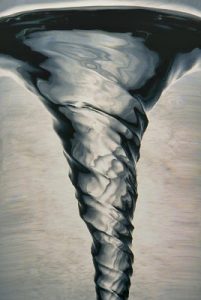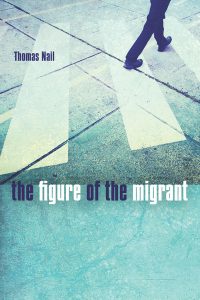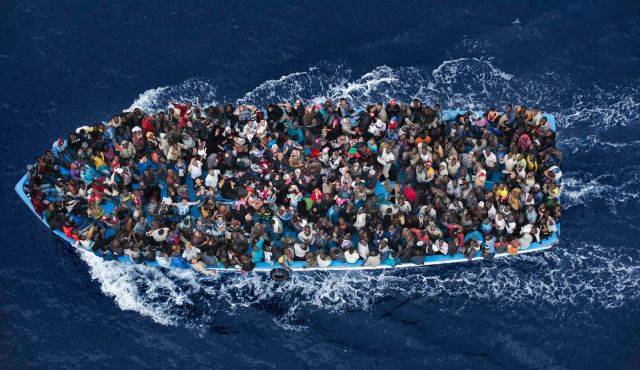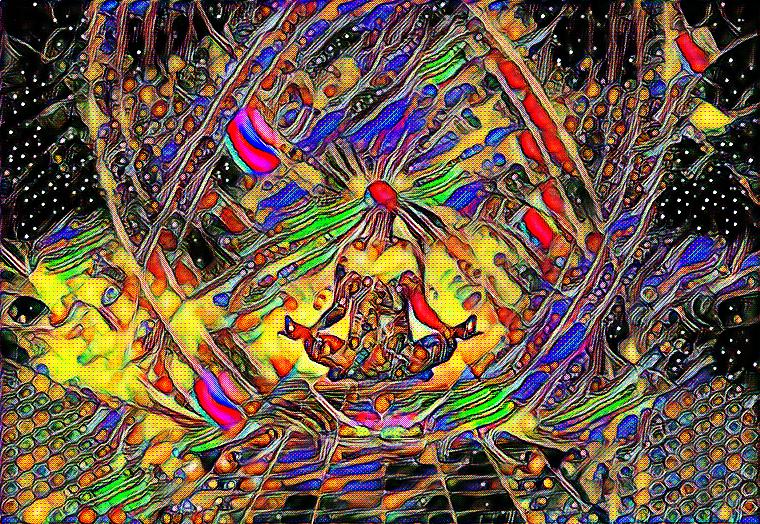 Nail, Thomas. The Figure of the Migrant. Stanford: Stanford University Press, 2015. ISBN-10: 0804796580. 312 pages.
Nail, Thomas. The Figure of the Migrant. Stanford: Stanford University Press, 2015. ISBN-10: 0804796580. 312 pages.
If the 21st century is indeed the century of the migrant, then Thomas Nail’s work is a timely consideration of this oft-neglected shadow of human civilization. To be precise, Nail argues for the necessity of this figure throughout terrestrial expansion and offers a retelling of human history from the perspective of migration. Not only does the migrant occupy a “central” place in Nail’s thought, but more importantly, she expresses the ontological primacy of motion itself.
In contrast to socio-political theories that privilege stasis, Nail presents an alternative metaphysical framework to support his reconsideration of political praxis—collectively named “kinopolitics.” In his own words, the book seeks to offer “an analysis of four major techniques for expelling migrants during their period of historical dominance and to provide a conceptual, movement-based definition of the migratory figures associated with these expulsions” (5, italics mine).
The four figures in this work are the nomad, the barbarian, the vagabond, and the proletariat. Each bears witness to a certain force at play, but none of them represent a complete dismissal of other movements; rather, each is a dynamic intersection that includes less accentuated patterns of motion. Despite the weight of his analysis, Nail manages to achieve remarkable clarity, and I would suggest that the result of Nail’s labor is a necessary refinement of the relationship between metaphysics and politics.
In this review, I have chosen to highlight the basic metaphysical framework of the argument as well as those “civilizing” forces at work in the last 10,000 years of human existence. This in no way discounts the second half of the book, which is the author’s attempt to examine non-expulsive motion. I simply feel that the earlier groundwork is crucial to anything else that happens in this text. Collectively, Nail’s introduction of an alternative metaphysical framework, his historico-political analysis of centralized regimes and their “disruptions,” and the precise application of his conceptual frame to contemporary migratory patterns, constitute a bold challenge to contemporary political theory.
The four figures that haunt this book are Marx, Bergson, Deleuze, and Foucault. In one sense, it can be seen as an amplification and extension of Marx’s basic insights concerning “primitive accumulation” and “surplus population,” both of which are prerequisites for the birth of the modern economy. But what Nail’s work also demonstrates are the dynamic forces at play in the generation of a certain periphery “exlusively included,” or “inclusively excluded” by a dominant social motion.
For many, this will sound strikingly similar to the work of Giorgio Agamben, but whereas Agamben prioritizes the role of the “sovereign decision” in the creation of “bare life,” Nail goes underneath the walls of the city, choosing to explore the subterranean movements that no boundary has been capable of preventing. In other words, the sovereign decision always follows the “labor” of people groups; it retroactively inserts itself as origin, but it is always derivative.
Kinopolitics is the alternative political theory afforded by a metaphysics that recognizes motion as primary. As a theory and analysis, kinopolitics understands all societies as “regimes of social motion” instead of static entities defined by legislative contours. Since Nail’s theory stands at a considerable distance from the prevailing trends of historico-political scholarship, he carefully but succinctly defines key terms for a political theory of movement. These are “flow,” “junction,” and “circulation.” Though clearly indebted to Foucault’s genealogical program, this work extends and sharpens Foucault’s analysis of historical epochs by establishing a metaphysics which Foucault often sought to avoid—herein lies Nail’s debt to Deleuze and Guattari’s A Thousand Plateaus.
As Nail admits, measuring a flow is difficult, and to be fair, his work does not seek to measure indivisible flows but rather understand phenomena in light of the flow as a conceptual basis. Inspired by early work in the fluid sciences (aerodynamics and hydrodynamics), he presupposes the continuum. A flow does not cease, but it might reduce speed. Though temporarily “blocked,” it simply finds a way around the obstacle. And this is precisely how national borders seek to control flows; not by “blocking or stopping them but rather by redirecting or slowing them down” (26). Thus, a politics of movement will always begin with an analysis of this continuous motion.
A junction refers to the perception of stasis, though it should be clear that movement is the fundamental condition for the possibility of “relative stasis.” It results from a single flow looping back over itself, in contrast to a confluence, which is the effect of overlapping heterogeneous flows. This vortical yoking acts like a filter that allows some flows to pass through and “captures” others in the repeating fold of the circle. Again, a junction is not a node; it is not a fixed point from which movement begins. Rather, a junction is the effect of movement—a concept that enables us to study certain flow “behaviors.”
Finally, both flows and junctions are essential ingredients for the circulation characteristic of all societies. As a regulation of flows into an ordered network of junctions, the “desire” of circulation is expansion. This leads to Nail’s reading of human history—or at least the past 10,000 years—as a movement of expansion by expulsion. Building on the three concepts above, he introduces a dialectic between conjoined and disjoined flows, limit and non-limit junctions, and circulation and re-circulation.
While indebted to Marx’s history of class struggle, Nail does refine our understanding of expulsion by describing it as both extensive and intensive (30). Each historical period examined in this text best illustrates a particular social force, which in itself describes the migrant-figure for that time. The first to be discussed is centripetal force.
Oddly, sedentarism is the first stage in the history of kinopower. As Nail writes, “the first dominant form of kinopower is the movement to delimit an area of the earth as socially distinct: to create a territory” (39). This delimitation is the creation of a center—a haptic circularity, moving from the outside in. But these many smaller centers/territories are slowly brought into a broader project of expansion that began through the initial yoking of soil, wind, and water. Internal territorial expulsion refers to the redirection of flows for the purpose of expanded circulation across a territory.
. . . plants and animals are disjoined from their natural growth and conjoined into circulation as crops, then disjoined by death, only to be conjoined again as food or as exchange later on . . . Animals are disjoined from their natural food source as human cropland destroys their environment. Their flows are then conjoined as domestic animals . . . This is also the case with humans. . . Hunter-gathering humans are disjoined from following the flows of moving animals and are then harnessed to the junctions of sedentary farming and husbandry. (44)
Of course, this internal expulsion is accompanied by an external expulsion, wherein plants, animals, and humans are simply expelled from the territory or destroyed. This process gives us the nomad, whose movement contrasts with territorial sedentarism.
From approximately 5000 BCE until the 5th century CE, the dominant form of kinopower transitions from territorial to political. This arrangement is simply the amplification of the social center created by territorial accumulation. Once it  manages to store up enough “potential energy,” it can then release a kinetic flow from the center outwards—centrifugal force. This explosion results in a more rigid, centralized management of flows. The initial steps taken to secure resources for a territory lead to the tyrannical direction of that society by the dominant social power of the capital.
manages to store up enough “potential energy,” it can then release a kinetic flow from the center outwards—centrifugal force. This explosion results in a more rigid, centralized management of flows. The initial steps taken to secure resources for a territory lead to the tyrannical direction of that society by the dominant social power of the capital.
Whereas territorial kinopower (centripetal force) exhibits asymmetrical social curves, political kinopower (centrifugal force) imposes a concentric, symmetrical curvature proper to the task of social glorification and ritual. Of course, this will only increase the storage-capacity of the center, which will in turn give rise to an even greater release of kinetic force i.e. taxes, military command, canals, roadways, etc. The invention of the wheel around 3000 BCE only serves to intensify this expansion.
The subsequent revolt against this centrifugal movement is named barbarian. The barbarian is the one made a slave or exterminated, the radiating center not being content with nomadic exile. A barbarian is one that cannot speak the language of the center (Greek), use the reason of the center (logos), and has an excessive geographic mobility in relation to the political center (polis).
Notwithstanding the strength of the political center, certain parts of the periphery inevitably break away and form their own junctions and motions. This “parcelized sovereignty” necessitates the emergence of the third form of kinopower: juridical. Whereas the previous two forms here analyzed operate with strict binarity, this new force—tensional—can allow for a degree of mobility.
However, this is deceptive, since the web of juridical linkages binds the human more than ever before. While the nomad had “room to roam” and the barbarians assembled their motions in resistance to the capital, the myriad linkages of this new social motion assured a tightly bound “vertical and horizontal network of legal ties” (63). The migratory figure associated with this regime is the vagabond: the one criminalized, outside of providential jurisprudence.
Benefiting heavily from Marx’s analysis of “surplus population,” Nail introduces the emergence of economic kinopower—elastic force. This motion results from the need to fill deficits in an effort to avoid social decline or collapse. Consequently, elasticity requires a surplus. Specifically, it requires three kinds: base surplus, the acceptable level of accumulated surplus; floating surplus, a buffer against future expansions and social contractions; future surplus, the surplus anticipated as necessary to maintain equilibrium or prepare for expansion.
Under this regime, circulation is intended to accomplish the movement of goods and services and functions “more like the management of a household than it does like the management of a state” (84). And this economic flow also engenders a certain migrant-figure: the proletariat. Though the proletariat is a much more complex figure and “includes a variety of integral subtypes” corresponding to the status of the worker—actively employed, underemployed, and unemployed—the scope of this review constrains me to a simple alignment of this figure with the different surpluses.
As foreshadowed by the conceptual dialectic introduced in the earlier sections of the text, each migratory figure (nomad, barbarian, vagabond, proletariat) embodies a motion contrary to that of the ruling power (the center). These “pedetic” forces can be examined through application of three social kinetic characteristics: continuous oscillation, waves, and pressure. Nail carefully uses these lenses to study the different historical periods and highlights the alternative (peripheral) social motions that refuse the dominance of the center. Having persuasively argued for the existence of these phenomena as conditions for societal transformation, he concludes his study with a lengthy analysis of the U.S.-Mexico border and the clash of motions it presents.
 Regardless of one’s position concerning his metaphysical suggestions, Nail’s reading of civilizational expansion through the lens of the fluid sciences offers an alternative to reductively materialist accounts of human behavior patterns. For this accomplishment alone, which is surely more than most books would even dare, his work is a required text for all those concerned with the dynamic conditions behind our present “state of affairs.”
Regardless of one’s position concerning his metaphysical suggestions, Nail’s reading of civilizational expansion through the lens of the fluid sciences offers an alternative to reductively materialist accounts of human behavior patterns. For this accomplishment alone, which is surely more than most books would even dare, his work is a required text for all those concerned with the dynamic conditions behind our present “state of affairs.”
However, there are some lingering questions, which I suspect the book never considered tackling. For example, if social forces operate analogous to those material forces studied by the natural sciences, then how can this theory avoid the problems of “agency” and “motivation” seemingly central to all political activity.
Granting the divided, incomplete, forever empty “subject” of postmodern thought, it remains difficult to imagine how “one or many” would ever act in a way other than that of the “flow” or “wave” into which they have been thrust. Riveted to the body as we are, and to those material conditions of history, how are we to escape, or better challenge, the structure of expansion by expulsion presented by Dr. Nail?
I suppose another way to ask this question would be, “If the human is simply a name for a confluence of flows and/or a filtering junction, then where is the disruption required to break out of the dominant forms of circulation? Is the human, after all, determined by the particular ratio of pressure to structure on which revolutions are predicated?” Nail does admit that he offers merely a conditional imperative a la Foucault: If one wants to resist, then here are some important things to know. But what motivates this “want”? From where would such desire to resist come?




